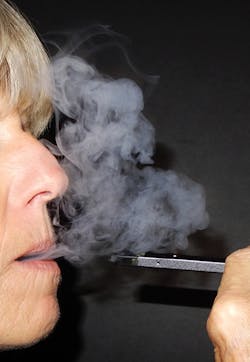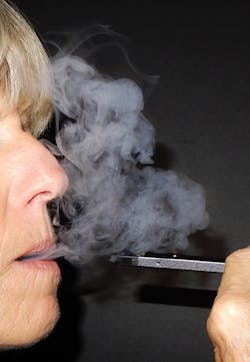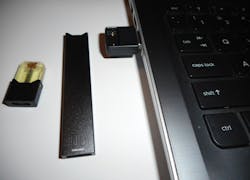Is your patient Juuling?
Discreet method of inhaling nicotine could lead to oral health concerns
Nancy W. Burkhart
Your patient tells you that she is Juuling and asks if there are any oral tissue problems that may occur in the future. “What is Juuling?” you ask. Just when you thought that you had heard of most devices, medications and substances that your patients may be using, this is a rather new one for you. She begins to tell you about her experience with Juul.
Most health-care providers are informed about current tobacco subject matter such as vaping products, electronic cigarettes, pens, betel quid, and toumbak. The concept of Juuling (pronounced as jewel) is rather new and a very trendy behavior for young adults—even used by adolescents. It has been referred to as the “iPhone of vapes” and charges on a laptop or other USB port. The Juul device is easy to use and discreet, and young adults are using these devices during school hours at rapid rates.
Some schools have called this to the attention of parents and teachers, and some schools have banned flash drive devices because the Juul devices resembles a normal computer Wi-Fi adapter and/or flash drive. This makes its use during school hours rather convenient. Another added benefit for users is that there is no tobacco odor to indicate that it is being consumed. The use is prevalent in many high schools and may go undetected by parents.
Subject is smoking a Juul. Courtesy of Carol Perkins, BA, AS, RDH.
A recent article by Felsenthal in Vogue Magazine (April 2018) describes user comments on why they use Juul. An example is: “It’s sleek, techie, tidy and can be discreetly used in places where smoking is banned.” Although e-cigarettes and vaping are well-recognized by youth, most consider Juuling as a separate concept and apart from either of these. Felsenthal called attention to the “glamorization” of the Juuling concept and mentioned that it is being used by well-known celebrities frequently as a “fashion statement.” that is certainly noticed by fans.
Although the device is somewhat discreet appearing as a flash drive device, users can purchase what is called “skins” and decorate their Juul devices, adding a personal look to them as a fashion statement.
Growing popularity
Since the arrival of the device, sales have skyrocketed, making it very marketable. The age range for sales may vary in states although the Juul is promoted as a device to be used by those ages 21 and over.
The Juul pod product is heated, inhaled, and sometimes exhaled with the option of re-inhaling the smoke again from the mouthpiece. The scent is unlike tobacco products and not easily detectable, making them even usable during class time without the instructor knowing that they are being used. Students will exhale the vapor into a hoody or a jacket. It is reported that the pods are used throughout the day by many students. Often the device is used in classrooms or restrooms during school hours.
The Juul device, an alternative to tobacco smoking, may also look like marijuana-adapted vapor devices. Ed Rosenthal wrote about this in his medical marijuana book and commented, “It looks like any other e-cig, and so long as you blow the vapor and not smoke, no one in public is the wiser.” These pens contain different amounts of cannabidiol (CBD) and tetrahydrocannabinol (THC).
With similar appearances, it may be difficult to ascertain just what the person may be using. The Juul device came on the market in 2015 and may be purchased online or in various vaping outlets. A Juul device utilizes a liquid that is heated through battery operated coils. The result is an aerosol that is inhaled by the user. A large puff of smoke is released, and the user inhales the released vapor. Newer generation devices, such as the Juul equipped with a high-capacity battery, deliver 35% to 72% increased nicotine.
Health concerns
The overall health of the individual is a real concern with the increased release of the nicotine products and the chemicals associated with any vaping device.
Each pod contains 0.7mL e-liquid with 5% nicotine by weight equivalent to about one pack of cigarettes. Most users report a very heavy “hit” of nicotine that is not found with most of the vaping devices; it is very concentrated. Nicotine-juiced pods are flavored and come in many different exotic scents/flavors.
Users of these types of products do not recognize the impact of the device and the delivery of a very large amount of nicotine with each use. According to a recent letter in the New England Journal of Medicine (2018), other hazardous chemicals are reported in e-cigarettes such as formaldehyde—a known degradation product of propylene glycol and glycerol during vaporization to produce hemiacetals. Formaldehyde is an International Agency for Research on Cancer group 1 carcinogen.
Reports suggesting respiratory symptoms, phlegm, congestion, persistent cough and bronchitis with burning in the throat are just a few side effects of vaping in general that have been reported. There have been reports of nicotine exposure leading to insulin resistance and type 2 diabetes, increased heart rate, and increased blood pressure with vaping devices. The added changes noted in the brain may lead to chronic addiction practices as well.
Juul power supply is inserted into a USB port. On the counter is the Juul pod. The vaporizer handle will be placed into the USB port, and an indicator light will show the level of battery life (green). After charging the device, the pod is attached to the handler. Courtesy of Carol Perkins, BA, AS, RDH.
Since there is no variation in nicotine dosage available, the user cannot incorporate the step-down approach, allowing a decreased amount of nicotine over time. Therefore, the Juul is not a device that can be recommended for those who want to decrease or quit nicotine use—a respectable goal often touted by the producers of vaping devices. Recent evidence suggests that vaping products in general lead to the use of other tobacco products such as cigarettes in the adolescent population (Chaffee, et al. 2018).
The Journal of the American Heart Association in an article titled, “The Impact of Electronic Cigarettes on the Cardiovascular System” (2017) states that the perception that e-cigarettes are a healthy alternative has contributed to the rising use of these devices. There has been a nine-fold increase among youth between 2011-2015. With the popularity of these newer devices, this number could drastically increase since the use of the Juuling product has driven up the sales of these types of devices in the last several years. Not only is it a vape device, but it has developed a “glamor-type” recognition that has become more of a social/cultural phenomenon with the youth.
The authors also cite that the toxic chemicals, volatile organic compounds, carbonyls, particulate matter, and nicotine are released into the atmosphere as second- and thirdhand exposure. E-cigarettes negatively affect the pulmonary system, immune system, central nervous system causing behavioral changes, and promote irritation of the mouth and throat. Users have noted that they detect a burning of the throat when inhaled. This is concerning for children, pregnant women, the elderly, and those individuals who have chronic diseases. The long-term effects to the oral tissues have not been documented, or what the changes may mean in future oral/oral-pharyngeal cancer. In general, there are no long-term studies on the tissue/cellular effects of the Juuling on the oral tissues, and we will see what these long-term changes may be over time.
Future projections
A recent article by Laura Bach in “Campaign for Tobacco Free Kids,” (March 2018) states that a starter kit on the Juul website includes the device, charger, and four Juul pods for $49. She also states that individuals may buy one kit and share with friends, making it less costly for the initial purchase. The sales of the device rapidly increased in 2017 and the long-term predicted sales are expected to continue to increase in the future.
The device may be touted as a mechanism to decrease tobacco use (something that is often referenced with most vape devices as a selling point). Currently, Juul products do not have a step-down approach to nicotine. Most tobacco specialists believe that the e-cigarettes and vape devices are gateway devices for other addiction products. The nicotine alone is highly addictive no matter what the source of delivery may be for the user.
The pleasant taste that is attributed to Juul pods makes it attractive to users. If first-time users do not like the taste, they may not continue to use the products, so the flavoring makes them more appealing. The ability to try different flavors make it more likely that the user will find a flavor they really like and submit to long-term use.
Juul handle is attached by its magnetized mouthpiece to its specialized USB that is connected to a laptop computer. The green LED indicator light means the device is charged and ready to be used.
Dental considerations
What can the dental professional contribute to the literature/documentation in the use of such products? With any new device, time will tell whether we can accumulate sufficient information to make informed recommendations regarding tissue changes that occur orally related to the JUUL or any other vaping device.
Some considerations regarding tissue changes may be:
There is always the future possibility of oral, oral-pharyngeal, and nasal cancer. Chronic tissue irritation/change with inflammation is detrimental to overall health.
How does the inhalation of chemicals, flavoring agents, and nicotine affect the oral tissues? We do know that the lungs will be affected through inhalation. We know that the esophageal tissue and nasal tissue may be affected as well as oral tissue. As stated previously, there is a reported burning sensation with initial inhaling. With the rise in HPV infection, will this add to harmful tissue changes in some patients? Because of this, is there the possibility of making oral pharyngeal cancer more likely for the Juuling person? Will the adolescent or younger person who appear to be using this product be more susceptible to these changes because of rapid cell division?
Oral tissue exposed to heat and chemicals results in melanosis because of the chronic exposure to heat, chemicals, and inflammation. Will these products contribute to tissue changes such as discoloration?
How much use will it take to see any effects? Are there long-term effects with the use of such high quantities of nicotine? As health-care providers, we are also assisting the patient in total health as well as oral health. Exposure to hazardous chemicals and nicotine does not promote health in any individual, especially in children and young adults.
Nicotine in any form is detrimental to youth, pregnant women, and the fetus, according to all health experts. We know that secondhand inhalation and exposure of these products is detrimental to individuals.
Should we be documenting tissue changes related to e-cigarettes and now JUUL devices or any other nicotine related products? Reporting such information is crucial in establishing a registry for such cases. Publications in dental, medical, and public health journals are needed for documentation.
The patient who asks about the use of such products is an active learner (a somewhat captive audience) and probably has friends who will benefit from what she learns today from you. Our role as dental professionals encompasses total health as well as oral health. Anything that impacts the health of our patients, should be a prime concern.
As always, continue to listen to your patients and always ask good questions.
Author’s note: The author would like to recognize Carol Perkins, BA, AS, RDH, who contributed to this column through interviews, research. and providing images for the article.
References
1. Bach L. Campaign for Tobacco Free Kids. March 20, 2018.
2. Chaffee BW, Watkins SL, Glantz SA. Electronic cigarette use and progression from experimentation to established smoking. Pediatrics 2018 Apr;141(4).
3. Hafner J. “Juul e-cigs: The controversial vaping device popular on school campuses,” USA Today, October 31, 2017, https://www.usatoday.com/story/money/nation-now/2017/10/31/juul-e-cigs-controversial-vaping-device-popular-school-campuses/818325001/.
4. JUUL Website, accessed April 2, 2018, https://www.juulvapor.com/shop-pods and https://www.juulvapor.com/limited-edition.
5. HHS, How Tobacco Smoke Causes Disease: The Biology and Behavioral Basis for Smoking-Attributable Disease: A Report of the Surgeon General, Centers for Disease Control and Prevention, Office on Smoking and Health, 2010 http://www.ncbi.nlm.nih.gov/books/NBK53017/.
6. HHS, E-Cigarette Use Among Youth and Young Adults. A Report of the Surgeon General. Atlanta, GA: U.S. Department of Health and Human Services, Centers for Disease Control and Prevention, National Center for Chronic Disease Prevention and Health Promotion, Office on Smoking and Health, 2016.
7. Qasim H, Karim ZA, Rivera JO, Khasawneh FT, Alshbool FZ. Impact of Electronic Cigarettes on the Cardiovascular System. Downloaded from http://jaha.ahajournals.org/ by guest on April 18, 2018
8. Inside Edition: New Teen Trend Called ‘Juuling’ is Raising Parental Concerns.
9. Rosenthal E, Downs D. Beyond Buds, Marijuana Extracts. 6th rev. ed. Piedmont California: Quick American 2014.
10. Routh J. “A mango-scented flash-drive-looking device lets kids smoke in class,” Pittsburg Post-Gazette, December 12, 2017, http://www.post- gazette.com/local/region/2017/12/12/JUUL-vaporizer-nicotine-flash-drive-small-concealable-e-cigarette/stories/201712120151.
11. The New England Journal of Medicine
Downloaded from nejm.org on April 18, 2018. engl j med 372;4 nejm.org january 22, 2015.
12. Felsenthal J. Smoke Signals. Vogue Magazine. April 2018.pg. 214, 229-230.
NANCY W. BURKHART,AFAAOM, BSDH, EdD, is an adjunct associate professor in the Department of Periodontics-Stomatology, College of Dentistry, Texas A&M University, Dallas, Texas. Dr. Burkhart is founder and cohost of the International Oral Lichen Planus Support Group https://dentistry.tamhsc.edu/olp/ and coauthor of General and Oral Pathology for the Dental Hygienist-In its 3rd ed. Nancy was awarded an Affiliate Fellow status in the American Academy of Oral Medicine in 2016. She was given the Dental Professional of the Year in 2017 through The International Pemphigus and Pemphigoid Foundation and is a 2017 Sunstar Award of Distinction Recipient. She can be contacted at [email protected]



